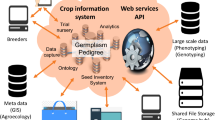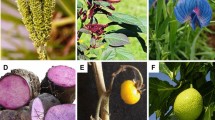Abstract
Key message
This review explores how speed breeding protocols that hasten plant growth and development could be applied to shorten breeding cycles and accelerate research activities in orphan crops.
Abstract
There is a growing need for the agri-food sector to sustainably produce larger quantities of higher-quality food, feed and fuel using fewer resources, within the context of changing agroclimatic conditions. Meeting this challenge will require the accelerated development and dissemination of improved plant varieties and substantial improvement of agricultural practices. Speed breeding protocols that shorten plant generation times can hasten breeding and research to help fulfil the ever-increasing demands. Global agri-food systems rely on a relatively small number of plant species; however, there are calls to widen the scope of globally important crops to include orphan crops, which are currently grown and used by the world’s poorest people or marketed as niche products for affluent consumers. Orphan crops can supply global diets with key nutrients, support economic development in the world’s poorest regions, and bolster the resilience of the global agri-food sector to biotic and abiotic stresses. Little research effort has been invested in orphan crops, with farmers growing landraces that are sourced and traded through poorly structured market systems. Efforts are underway to develop breeding resources and techniques to improve orphan crops. Here, we highlight the current efforts and opportunities to speed breed orphan crops and discuss alternative approaches to deploy speed breeding in the less-resourced regions of the world. Speed breeding is a tool that, when used together with other multidisciplinary R&D approaches, can contribute to the rapid creation of new crop varieties, agricultural practices and products, supporting the production and utilisation of orphan crops at a commercial scale.
Similar content being viewed by others
References
African Orphan Crops Consortium (2018) African Orphan Crops Consortium. http://africanorphancrops.org/. Accessed 3 Aug 2018
Alexandratos N, Bruinsma J (2012) World agriculture towards 2030/2050: the 2012 revision. FAO, Rome
Amare E, Mouquet-Rivier C, Servent A et al (2015) Protein quality of amaranth grains cultivated in Ethiopia as affected by popping and fermentation. Food Nutr Sci. https://doi.org/10.4236/fns.2015.61005
Baier KM, Maynard C, Powell W (2012) Early flowering in chestnut species induced under high dose light in growth chambers. J Am Chestnut Found 26:8–10
BBC (2018) Nigerian entrepreneur: “We’re farming in a shipping container.” https://www.bbc.com/news/av/business-42919553/nigerian-entrepreneur-we-re-farming-in-a-shipping-container. Accessed 7 Aug 2018
Ceballos H, Hershey C, Becerra-López-Lavalle LA (2012) New approaches to cassava breeding. Plant Breed Rev 36:427–504. https://doi.org/10.1002/9781118358566.ch6
Ceballos H, Jaramillo JJ, Salazar S et al (2017) Induction of flowering in cassava through grafting. J Plant Breed Crop Sci 9:19–29
Clifton-Brown J, Hastings A, Mos M et al (2017) Progress in upscaling Miscanthus biomass production for the European bio-economy with seed-based hybrids. GCB Bioenergy. https://doi.org/10.1111/gcbb.12357
Collard BCY, Beredo JC, Lenaerts B et al (2017) Revisiting rice breeding methods—evaluating the use of rapid generation advance (RGA) for routine rice breeding. Plant Prod Sci 20:337–352. https://doi.org/10.1080/1343943X.2017.1391705
CropBox (2018) A new, smarter way to farm. http://cropbox.co. Accessed 15 Aug 2018
Croser JS, Pazos-Navarro M, Bennett RG et al (2016) Time to flowering of temperate pulses in vivo and generation turnover in vivo–in vitro of narrow-leaf lupin accelerated by low red to far-red ratio and high intensity in the far-red region. Plant Cell Tissue Organ Cult 127:591–599. https://doi.org/10.1007/s11240-016-1092-4
Dinssa FF, Yang R-Y, Ledesma DR et al (2018) Effect of leaf harvest on grain yield and nutrient content of diverse amaranth entries. Sci Hortic (Amsterdam) 236:146–157. https://doi.org/10.1016/j.scienta.2018.03.028
Ebert AW (2014) Potential of underutilized traditional vegetables and legume crops to contribute to food and nutritional security, income and more sustainable production systems. Sustainability 6:319–335. https://doi.org/10.3390/su6010319
Ehrlich PR, Harte J (2015) Opinion: to feed the world in 2050 will require a global revolution. Proc Natl Acad Sci 112:14743–14744
Falconer DS, Mackay TFC (1996) Introduction to quantitative genetics. Longman, New York
Fox JL (2013) Mars collaborates to sequence Africa’s neglected food crops. Nat Biotechnol 31:867
Gaur P, Samineni S, Laxmipathi Gowda C, Rao BV (2007) Rapid generation advancement in chickpea. SAT eJ 3:1–3
Ghosh S, Watson A, Gonzalez-Navarro OE et al (2018) Speed breeding in growth chambers and glasshouses for crop breeding and model plant research. bioRxiv. https://doi.org/10.1101/369512
Godfray HCJ, Beddington JR, Crute IR et al (2010) Theme Issue ‘Food security: feeding the world in 2050’. Philos Trans R Soc Biol Sci 365:2765–3097
Heslop-Harrison JS, Schwarzacher T (2007) Domestication, genomics and the future for banana. Ann Bot 100:1073–1084
Hickey JM, Chiurugwi T, Mackay I et al (2017) Genomic prediction unifies animal and plant breeding programs to form platforms for biological discovery. Nat Genet 49:1297–1303
Jamnadass RH, McMullin S, Iiyama M et al (2015) Understanding the roles of forests and tree-based systems in food provision. In: Vira B, Wildburge C, Mansourian S (eds) Forests, trees and landscapes for food security and nutrition: a global assessment report. International Union of Forest Research Organizations (IUFRO), Viena, pp 25–50
Joshi DC, Sood S, Hosahatti R et al (2018) From zero to hero: the past, present and future of grain amaranth breeding. Theor Appl Genet 131:1807. https://doi.org/10.1007/s00122-018-3138-y
Keating BA, Evenson JP, Fukai S (1982) Environmental effects on growth and development of cassava (Manihot esculenta Crantz.) I. Crop development. Field Crop Res 5:271–281. https://doi.org/10.1016/0378-4290(82)90030-2
Khoury CK, Bjorkman AD, Dempewolf H et al (2014) Increasing homogeneity in global food supplies and the implications for food security. Proc Natl Acad Sci 111:4001–4006
Kole C (2007) Pulses, sugar and tuber crops. Springer, Berlin
Korbo A, Kjær ED, Sanou H et al (2013) Breeding for high production of leaves of baobab (Adansonia digitata L.) in an irrigated hedge system. Tree Genet Genom 9:779. https://doi.org/10.1007/s11295-013-0595-y
Kumar V, Khan AW, Saxena RK et al (2016) First-generation HapMap in Cajanus spp. reveals untapped variations in parental lines of mapping populations. Plant Biotechnol J 14:1673–1681. https://doi.org/10.1111/pbi.12528
Li H, Rasheed A, Hickey LT, He Z (2018) Fast-forwarding genetic gain. Trends Plant Sci 23:184–186. https://doi.org/10.1016/j.tplants.2018.01.007
Lulsdorf MM, Banniza S (2018) Rapid generation cycling of an F2 population derived from a cross between Lens culinaris Medik. and Lens ervoides (Brign.) Grande after aphanomyces root rot selection. Plant Breed 137:486–491. https://doi.org/10.1111/pbr.12612
Lush JL (1943) Animal breeding plans. The Iowa State College Press, Ames
Lynch M, Walsh B (1998) Genetics and analysis of quantitative traits. Sinauer Associates Inc, Sunderland
Massawe F, Mayes S, Cheng A (2016) Crop diversity: an unexploited treasure trove for food security. Trends Plant Sci 21:365–368. https://doi.org/10.1016/j.tplants.2016.02.006
Mitchell ML, Norman HC, Whalley RDB (2015) Use of functional traits to identify Australian forage grasses, legumes and shrubs for domestication and use in pastoral areas under a changing climate. Crop Pasture Sci 66:71–89
Mobini SH, Lulsdorf M, Warkentin TD, Vandenberg A (2015) Plant growth regulators improve in vitro flowering and rapid generation advancement in lentil and faba bean. In Vitro Cell Dev Biol Plant 51:71–79. https://doi.org/10.1007/s11627-014-9647-8
Naylor RL, Falcon WP, Goodman RM et al (2004) Biotechnology in the developing world: a case for increased investments in orphan crops. Food Policy 29:15–44. https://doi.org/10.1016/j.foodpol.2004.01.002
Nelson RJ, Naylor RL, Jahn MM (2004) The role of genomics research in improvement of “orphan” crops. Crop Sci 44:1901–1904. https://doi.org/10.2135/cropsci2004.1901
NextGen Cassava (2018) Next generation cassava breeding project. http://www.nextgencassava.org/index.html. Accessed 3 Aug 2018
Nichols PGH, Revell CK, Humphries AW et al (2012) Temperate pasture legumes in Australia—their history, current use, and future prospects. Crop Pasture Sci 63:691–725. https://doi.org/10.1071/CP12194
O’Connor DJ, Wright GC, Dieters MJ et al (2013) Development and application of speed breeding technologies in a commercial peanut breeding program. Peanut Sci 40:107–114. https://doi.org/10.3146/ps12-12.1
Pazhamala L, Saxena RK, Singh VK et al (2015) Genomics-assisted breeding for boosting crop improvement in pigeonpea (Cajanus cajan). Front Plant Sci 6:50. https://doi.org/10.3389/fpls.2015.00050
Pazos-Navarro M, Castello M, Bennett RG et al (2017) In vitro-assisted single-seed descent for breeding-cycle compression in subterranean clover (Trifolium subterraneum L.). Crop Pasture Sci 68:958–966. https://doi.org/10.1071/CP17067
Reynolds D, Baret F, Welcker C et al (2018) What is cost-efficient phenotyping? optimizing costs for different scenarios. Plant Sci 1:48. https://doi.org/10.1016/j.plantsci.2018.06.015
Saenz A (2011) Transforming shipping containers into local farms—podponics brings produce to the city. In: Singul. Hub. https://singularityhub.com/2011/08/30/transforming-shipping-containers-into-local-farms-podponics-brings-produce-to-the-city/#sm.000100v3z66e9fdyt062k15j3s238. Accessed 7 Aug 2018
Sethi SC, Byth DE, Gowda CLL, Green JM (1981) Photoperiodic response and accelerated generation turnover in chickpea. Field Crop Res 4:215–225. https://doi.org/10.1016/0378-4290(81)90073-3
Shi Y, Thomasson JA, Murray SC et al (2016) Unmanned aerial vehicles for high-throughput phenotyping and agronomic research. PLoS ONE 11:e0159781
Siddique KHM, Brinsmead RB, Knight R, et al (2000) Adaptation of chickpea (Cicer arietinum L.) and faba bean (Vicia faba L.) to Australia. In: Knight R (ed) Linking research and marketing opportunities for pulses in the 21st century: proceedings of the third international food legumes research conference. Springer, Dordrecht, pp 289–303
Silva Souza L, Diniz RP, de Jesus Neves R et al (2018) Grafting as a strategy to increase flowering of cassava. Sci Hortic (Amsterdam) 240:544–551. https://doi.org/10.1016/j.scienta.2018.06.070
Sogbohossou EOD, Achigan-Dako EG, Maundu P et al (2018) A roadmap for breeding orphan leafy vegetable species: a case study of Gynandropsis gynandra (Cleomaceae). Hortic Res 5:2. https://doi.org/10.1038/s41438-017-0001-2
Stetter MG, Zeitler L, Steinhaus A et al (2016) Crossing methods and cultivation conditions for rapid production of segregating populations in three grain amaranth species. Front Plant Sci 7:816. https://doi.org/10.3389/fpls.2016.00816
Sundström JF, Albihn A, Boqvist S et al (2014) Future threats to agricultural food production posed by environmental degradation, climate change, and animal and plant diseases—a risk analysis in three economic and climate settings. Food Secur 6:201–215. https://doi.org/10.1007/s12571-014-0331-y
Tadele Z (2018) African orphan crops under abiotic stresses: challenges and opportunities. Scientifica (Cairo). https://doi.org/10.1155/2018/1451894
van Nocker S, Gardiner SE (2014) Breeding better cultivars, faster: applications of new technologies for the rapid deployment of superior horticultural tree crops. Hortic Res 1:14022. https://doi.org/10.1038/hortres.2014.22
Varshney RK, Ribaut J-M, Buckler ES et al (2012) Can genomics boost productivity of orphan crops? Nat Biotechnol 30:1172–1176. https://doi.org/10.1038/hortres.2014.22
Wang S, Ebert A (2012) Breeding of leafy amaranth for adaptation to climate change. In: Regional symposium on high value vegetables in Southeast Asia: production, supply and demand (SEAVEG2012). VRDC—The World Vegetable Center, Chiang Mai
Watson A, Ghosh S, Williams MJ et al (2018) Speed breeding is a powerful tool to accelerate crop research and breeding. Nat Plants 4:23–29. https://doi.org/10.1038/s41477-017-0083-8
Weinberger K (2007) Are Indigenous vegetables underutilized crops? some evidence from eastern Africa and South East Asia. Acta Hortic 752:29–34. https://doi.org/10.17660/ActaHortic.2007.752.1
Wilson JE (1979) Promotion of flowering and production of seed in cocoyam (Xanthosoma and Colocasia). In: 5th international symposium on tropical root crops held in Manila, Philippines, pp 17–21
Wolfe MD, Del Carpio DP, Alabi O et al (2017) Prospects for genomic selection in cassava breeding. Plant Genome. https://doi.org/10.3835/plantgenome2017.03.0015
Yang G, Liu J, Zhao C et al (2017) Unmanned aerial vehicle remote sensing for field-based crop phenotyping: current status and perspectives. Front Plant Sci 8:1111. https://doi.org/10.3389/fpls.2017.01111
Acknowledgements
We are grateful to Graeme Wright (Peanut Company of Australia) for providing a photograph of peanut plants growing under speed breeding conditions (Fig. 1a) and Cathie Martin and Abhimanyu Sarkar (John Innes Centre) for providing a photograph of grass pea growing under speed breeding conditions (Fig. 1b). The authors would like to thank the Australian Research Council for support through an Early Career Discovery Research Award to Lee Hickey (DE170101296).
Author information
Authors and Affiliations
Corresponding authors
Ethics declarations
Conflict of interest
The authors declare that they have no conflict of interest.
Additional information
Communicated by Tobias Würschum.
Rights and permissions
About this article
Cite this article
Chiurugwi, T., Kemp, S., Powell, W. et al. Speed breeding orphan crops. Theor Appl Genet 132, 607–616 (2019). https://doi.org/10.1007/s00122-018-3202-7
Received:
Accepted:
Published:
Issue Date:
DOI: https://doi.org/10.1007/s00122-018-3202-7







